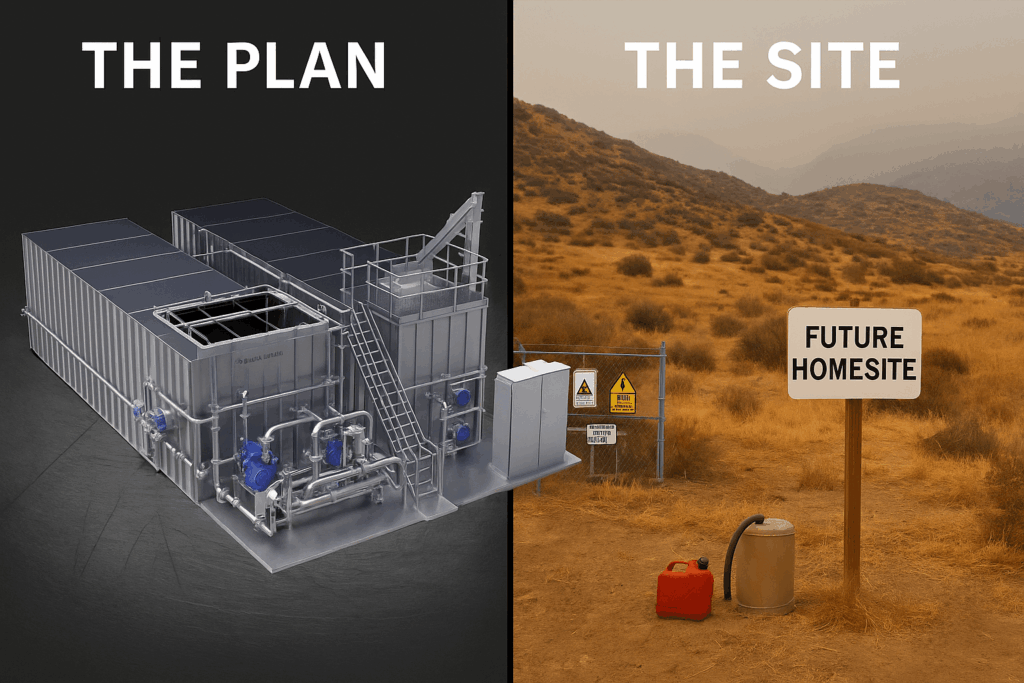No Sewer. No Backup. No Excuse.
This blog features community commentary, editorial opinions, visual interpretations, and based on publicly available documents. Some images, whether labeled or stylized, are included for advocacy and awareness purposes. They may not represent final or official development plans.

There is no city sewer infrastructure on the east end of Moreno Valley.
Homes rely on septic systems, not just on the hillside but even in the developed areas east of Nason and north of the 60 freeway.
This image is an artist’s rendition based on public records and manufacturer information. It is not part of the developer’s submissions to the county, but reflects our understanding of what a typical Cloacina MEMPAC system may look like on a similar site. Included for advocacy and awareness purposes only.
And yet, a developer is proposing to place 350 high-density homes on a rural parcel with no city sewer line access, in the middle of a fire zone, floodplain, and mapped earthquake fault zone.
The Solution? A Machine That Has to Work 24/7
Instead of building out city sewer, the developer proposes using a Cloacina MEMPAC sewage treatment unit, a large, industrial-scale machine designed to process thousands of gallons of human waste every single day.
On paper, it sounds efficient. In practice, it’s a system that must:
- Run 24/7
- Remain powered at all times
- Rely on a backup generator during outages
- Store fuel — in a fire-prone area
And all of that would need to work flawlessly in a disaster-prone hillside, where roads are limited, and wildfire conditions can change by the hour.
How Much Waste Are We Talking About?
With 350 homes, it’s reasonable to estimate 1,000 to 1,400 people. That’s a small town’s worth of sewage, with no city sewer connection and no backup plan if the system fails.
- – No gravity-fed fallback
- No municipal pump station
- No public plan for fire-season outages or prolonged generator downtime
If the power goes out, the system backs up.
And if the system backs up, we’re facing a hazardous materials emergency, not just a bad smell.
This Isn’t Normal — It’s Hyperdensity
The flatter eastern portion of this area spans roughly 1,300 acres. While not all of the land is built out, there are about 430 homes across it, many on large rural lots.
Now compare that to what’s being proposed:
350 homes crammed into just 38 acres
That’s a density over 10 times higher than the surrounding community, jammed into a hillside with no sewer, no transit, and no real margin for error.
And the solution is a single sewage processor?
That’s not planning. That’s gambling with people’s health and safety.
Sewer Before Rooftops
No one’s saying growth isn’t needed. However, growth without basic infrastructure, like sewer access, is not progress. It’s negligence.
A project like this would never be approved in Redlands or Loma Linda. So why is it being proposed here?
What’s at Stake?
A failed sewage system doesn’t just smell bad. It:
- Pollutes groundwater
- Endangers nearby homes and wildlife
- Requires fuel storage in fire-prone zones
- Creates massive public health liabilities
This isn’t about slowing down housing.
It’s about doing it responsibly — with real planning, not magical thinking.
Get Involved
📣 Join the Moreno Badlands Conservancy
We’re residents, not activists — but we’ve had enough of unsafe, shortsighted planning.
Read more at morenobadlands.org
Use our Comment Help Center to speak up
Let’s build wisely and stop flushing our future down the hillside.
